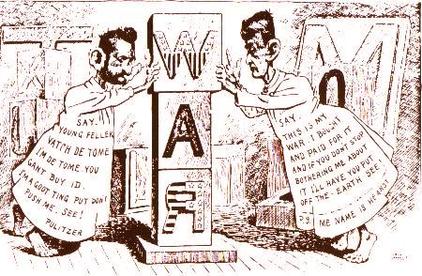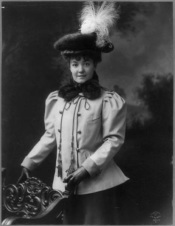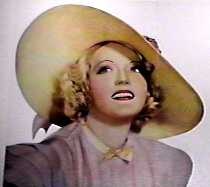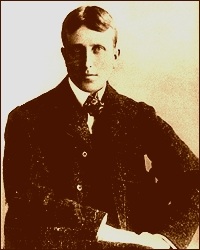William Randolph Hearst was born to George Randolph Hearst and Phoebe Apperton Hearst on April 29, 1863 in California. His father, George Hearst, was one of the lucky few miners who struck it rich in the California mining business. George Hearst dedicated his time to investments in his many shares of mines across the country, and as a result, spent hardly any time at all with William Randolph Hearst during his childhood. Phoebe Apperton Hearst, in contrast, doted on her son. She ensured that he received only the best education, complete with private tutors and educational tours of Europe.
After William Hearst returned to California from his 18-month tour of Europe with his mother, he was enrolled at the age of sixteen to St. Paul's Preparatory School in Concord, New Hampshire. Afterwards, he attended Harvard College, but was expelled in 1885 because he played a prank on his professors. Two years later, he received ownership of the San Francisco Examiner from his father, who had earned it himself in 1880 as repayment of a gambling debt. This newspaper was the first serious beginning to Hearst's career as a journalist.
Hearst hired the best writers and bought the finest printing equipment. He completely took over the San Francisco Examiner, proclaiming himself its proprietor. He filled his stories with corruption and drama, determined to make his publication popular with the American public. He realized that, to accomplish his dream of a newspaper empire, he would have to move headquarters to the more central New York City. His goal was fulfilled in 1895, when he acquired the failing New York Morning Journal.

Pulitzer (right) and Hearst (left) struggling over the Spanish American war
Within a year Hearst had turned the Morning Journal into the best and finest newspaper in New York City, directly competing with Joseph Pulitzer's New York World. Hearst soon developed a reputation for hiring the best possible reporters. He supported his booming industry by paying his journalists huge amounts of money. To further advance his struggles against Pulitzer, Hearst started reporting increasingly outrageous stories, striving to make his audience as large as possible. This ferocious and exaggerated type of journalism came to be known as "yellow journalism", named after a comic strip "The Yellow Kid" featured in Hearst's newspaper and drawn by R.F. Outcault.
“News is something somebody doesn't want printed; all else is
advertising.”
-- William Randolph Hearst
advertising.”
-- William Randolph Hearst
An example of Hearst's most extreme yellow journalism is said to have contributed to the start of the Mexican-American war. Always pushing for more readers, Hearst tried to make the most sensationalist stories out of any bit of news he could find. When an explosion in Cuba sank the Maine, a United States battleship, and killed hundreds of U.S. soldiers in 1898, Hearst immediately blamed the deed on the Spanish. Though other journalists cautioned him about taking the story too far, Hearst had his own plans. Two days after the explosion, his headlines were calling for immediate war: "War? Sure!"
Hearst quickly acquired more newspapers, expanding to Chicago, Boston, and Los Angeles with the Chicago American in 1900, the Chicago Examiner in 1902, and the Boston American and the Los Angeles Examiner in 1904. His media empire, which included newspapers, magazines, radio shows, and movies, was in its heyday in the late 1920s, when one in four Americans read a Hearst newspaper daily.
Using his great media background to support himself, Hearst dabbled in politics. He was elected to the House of Representatives twice, once in 1902 and once in 1904. However, his duties as a journalist kept him away from much active participation in Congress, angering many of his voters and coworkers. After unsuccessfully running for Mayor of New York City in 1905 and Governor of New York in 1906, Hearst gave up his political career.
Hearst quickly acquired more newspapers, expanding to Chicago, Boston, and Los Angeles with the Chicago American in 1900, the Chicago Examiner in 1902, and the Boston American and the Los Angeles Examiner in 1904. His media empire, which included newspapers, magazines, radio shows, and movies, was in its heyday in the late 1920s, when one in four Americans read a Hearst newspaper daily.
Using his great media background to support himself, Hearst dabbled in politics. He was elected to the House of Representatives twice, once in 1902 and once in 1904. However, his duties as a journalist kept him away from much active participation in Congress, angering many of his voters and coworkers. After unsuccessfully running for Mayor of New York City in 1905 and Governor of New York in 1906, Hearst gave up his political career.

Millicent Wilson, William Randolph Hearst's wife and mother of five children
In 1903, Hearst married Millicent Wilson. Together, they had five children: George Randolph Hearst, born in 1904, William Randolph Hearst, Jr., born in 1908, John Randolph Hearst, born in 1910, and twins Randolph Apperton Hearst and David Whitmire, born in 1915. Their marriage did not last. In 1919 Hearst started living with Marian Davies, a 21-year-old chorus girl. Despite the fact that she was 34 years his junior, the two lived together until the end of Hearst's life

Marian Davies, Hearst's longtime mistress
Phoebe Hearst died in 1919, giving Hearst the opportunity to live on the family's 268,000-acre ranch in California. On this land Hearst build what is now called "Hearst Castle", a luxurious mansion with giant swimming pools, gardens, a private zoo, and the largest private art collection in the world.
The Great Depression hit Hearst hard. The great pressure on his media world caught up with his spending and his empire collapsed. It is possible that he never made much income from his newspapers and his whole corporation was supported by his own personal wealth, earned from his father's mining investments. During the Great Depression consumer numbers plummeted, and Hearst was left without a cause. World War II in 1939 and the end of the Depression helped bring back some of his former glory, but his media never returned to the peak circulation it once had.
Hearst was a philanthropist, donating his money to good causes and establishing the Hearst Foundation in 1945. This foundation still stands today. William Randolph Hearst died on August 14, 1951, at his home in Beverly Hills, California. Hearst was one of the most influential and controversial people of his time. He revolutionized media and created the foundation for newspapers and journaling today.

